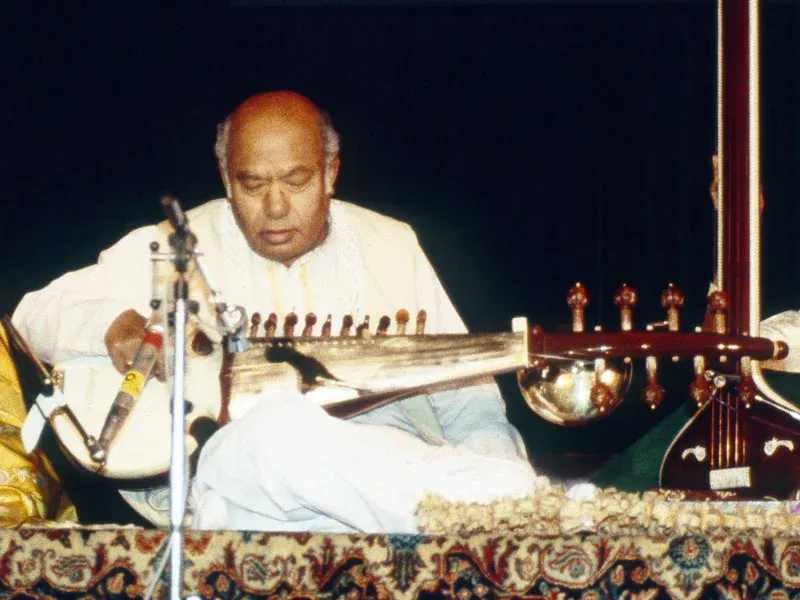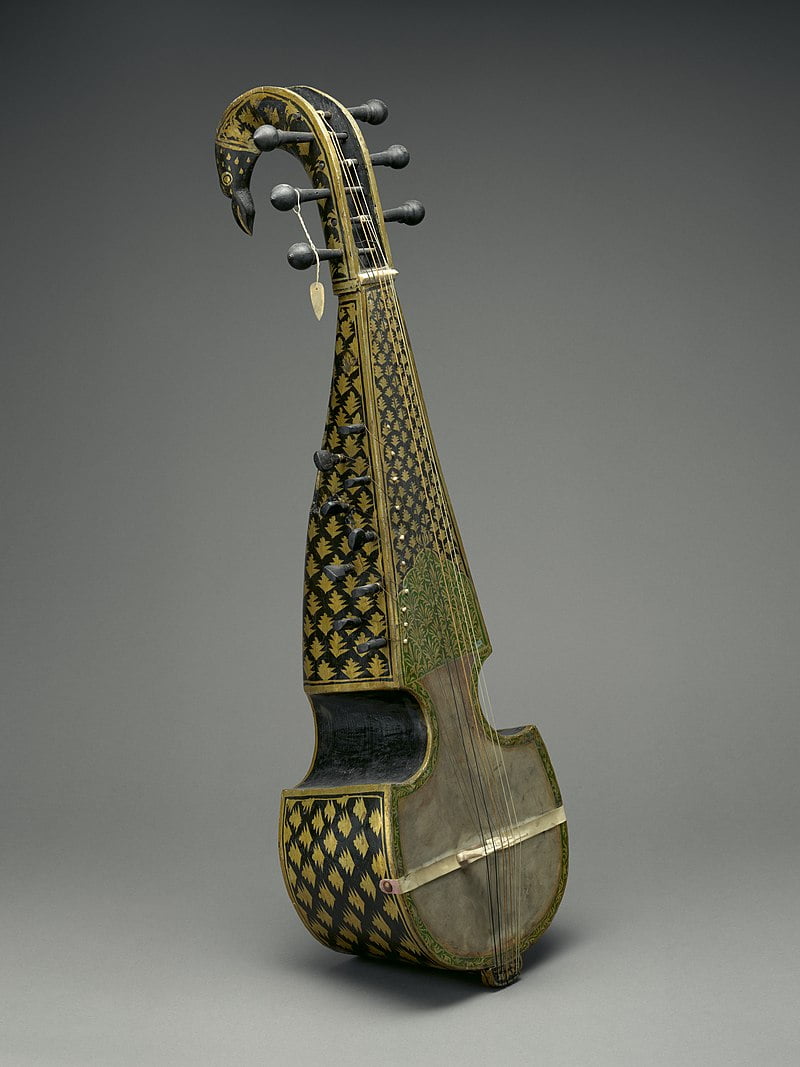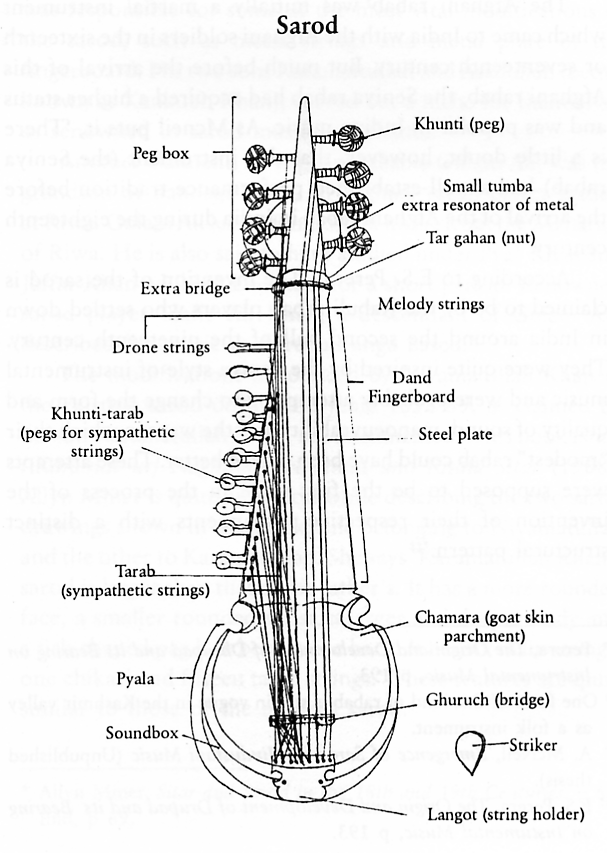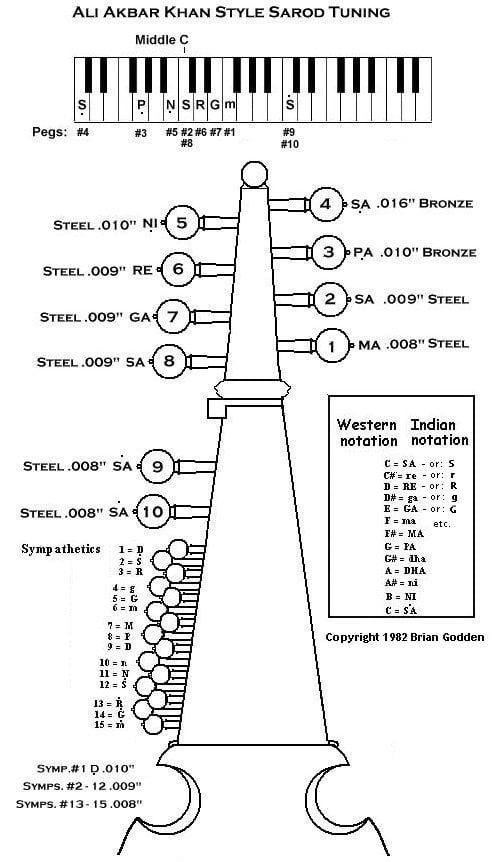An Essential Guide to Understanding the Fundamentals of the Sarod

India is known for its rich and diverse cultural heritage, and one of the most remarkable aspects of this heritage is its classical music. Deeply rooted in tradition and spirituality, Indian classical music is a treasure trove of melodies, rhythms, and improvisations that have captivated audiences for centuries. At the heart of this enchanting musical tradition lies a mesmerizing instrument known as the sarod.
The sarod holds a prominent place among the stringed instruments of Indian classical music. With its soul-stirring sound and intricate playing techniques, the sarod has become synonymous with the mesmerizing melodic journeys and emotive expressions of this ancient musical form. In this article, we embark on an exploration of the sarod, delving into its history, construction, playing technique, and significance within Indian classical music.

The origins of the sarod can be traced back to ancient times. Over the centuries, it has evolved and undergone significant transformations, becoming the instrument we recognize today. The sarod’s evolution has been shaped by the contributions of legendary musicians and renowned families who have dedicated themselves to the preservation and advancement of Indian classical music.
Before we delve deeper into the sarod’s history, it is important to understand its physical structure. The sarod consists of a resonating chamber made of wood, typically teak or mahogany, which amplifies the sound produced by its strings. The instrument features a flat fingerboard, metal strings, and a distinctive soundboard covered with goatskin. This unique construction gives the sarod its characteristic tonal quality and allows for the dynamic range and expressiveness it is known for.
Playing the sarod requires mastery of a complex technique that involves intricate finger positioning, fluid hand movements, and skillful striking of the strings. The sarod player employs a set of metal finger picks attached to the index and middle fingers to pluck the strings, while the thumb supports the instrument’s neck. The technique of sliding between notes, known as meend, and the use of ornamentation techniques like gamak, contribute to the sarod’s expressive capabilities and allow the musician to create intricate melodic patterns and embellishments.
The sarod has developed distinctive styles and schools of playing, known as gharanas, each with its own unique characteristics and repertoire. These gharanas have been nurtured and passed down through generations, carrying forward the legacy of legendary sarod players. From the soulful and introspective style of the Senia gharana to the virtuosic and energetic approach of the Shahjahanpur gharana, each gharana adds its own flavor to the sarod’s repertoire.
Beyond its role in Indian classical music, the sarod has left a lasting impact on the global music scene. Its mesmerizing sound and evocative melodies have transcended cultural boundaries, captivating audiences around the world. The sarod has also found its place in collaborations with artists from different musical traditions, contributing to the evolution of world music and fusion genres.
As we journey through the world of the sarod, we will explore its historical roots, examine its construction and playing technique, delve into the diverse gharanas of sarod playing, and understand its significance within Indian classical music. Join us as we unravel the secrets of this enchanting instrument and discover the timeless beauty it brings to the world of music.
Historical Background of the Sarod
The sarod has a rich and fascinating history that spans centuries, with its roots deeply intertwined with the evolution of Indian classical music. To understand the journey of the sarod, we must delve into its historical background and explore the influences and contributions that have shaped its development.
The origins of the sarod can be traced back to ancient musical instruments such as the Rabab, which existed in the Indian subcontinent as early as the 1st century CE. The Rabab was a stringed instrument played with a bow, and it played a significant role in the development of the sarod. Over time, the Rabab underwent modifications, with musicians experimenting and introducing changes to enhance its tonal quality and adaptability.
It was during the medieval period, around the 18th century, that the sarod, as we know it today, began to take shape. The legendary musician and composer Ustad Ali Akbar Khan, who is often credited with the modernization and popularization of the sarod, played a pivotal role during this period. Ustad Ali Akbar Khan, along with his father Ustad Allauddin Khan, transformed the sarod into a solo instrument capable of producing intricate melodies and emotive expressions.
The contributions of the legendary musician and scholar, Ustad Wazir Khan, cannot be overlooked either. He played a significant role in refining the instrument and developing the gayaki ang (vocal style) of sarod playing, which sought to emulate the nuances of human voice through the instrument. Ustad Wazir Khan’s innovations further solidified the sarod’s position as a solo instrument capable of expressing a wide range of emotions.
The sarod’s development was also influenced by the contributions of various gharanas (schools) and the musicians associated with them. The Senia gharana, founded by the legendary Mian Tansen, played a crucial role in shaping the sarod’s early development. The Shahjahanpur gharana, known for its virtuosic and rhythmic style, added its unique flavor to the sarod repertoire. Other prominent gharanas, such as the Maihar, Lucknow, and Indore gharanas, also made significant contributions to the sarod’s evolution.
Throughout its history, the sarod has been nurtured and advanced by renowned families of musicians who have dedicated themselves to preserving and pushing the boundaries of Indian classical music. These families, such as the Bangash family and the Khan family, have passed down the rich tradition of sarod playing from one generation to the next, ensuring its continuity and growth.
Today, the sarod continues to flourish, with virtuoso players and talented musicians pushing the boundaries of its possibilities. The instrument has gained global recognition and has become an integral part of concerts and performances, not just in India but also in prestigious venues around the world.
Anatomy and Construction of the Sarod
To truly appreciate the beauty and intricacy of the sarod, it is essential to understand its anatomy and the craftsmanship involved in its construction. The physical characteristics of the sarod, along with the materials used, contribute to its unique sound and playability.
The sarod consists of several key components that work together harmoniously to produce its distinctive tonal quality. At the heart of the instrument is the resonating chamber, commonly made of teak or mahogany wood. The resonating chamber amplifies the sound produced by the strings, giving the sarod its rich and resonant character.
The fingerboard of the sarod is flat and usually made of polished steel or ebony. This smooth surface allows for effortless movement of the fingers, facilitating the intricate playing techniques employed by sarod players. The fingerboard is divided into movable frets, which enable precise intonation and the ability to play microtonal nuances that are characteristic of Indian classical music.
The strings of the sarod are typically made of metal, with the most common configuration being four main playing strings and a number of sympathetic strings. The playing strings are usually made of bronze or steel and are plucked with metal finger picks. These finger picks, often made of metal or celluloid, are attached to the index and middle fingers and enable the player to produce a clear and resonant sound when striking the strings.

One of the distinctive features of the sarod is its soundboard, which is covered with goatskin. The goatskin is stretched tightly over the soundboard, enhancing the resonance and tonal quality of the instrument. The soundboard also features two soundholes, typically in the shape of crescents or circles, which allow the sound to escape and resonate freely.
Crafting a sarod requires a high level of skill and expertise. Master craftsmen meticulously carve and shape the resonating chamber, carefully selecting the type of wood that will produce the desired tonal characteristics. The fingerboard is meticulously crafted, ensuring its smoothness and accuracy in terms of fret placement. The metal strings are carefully selected and adjusted to achieve optimal tension and tonal balance.
The process of building a sarod involves a delicate balance between tradition and innovation. While the basic design and construction techniques have been passed down through generations, modern luthiers often incorporate advancements in materials and construction methods to further refine the instrument’s sound and playability. This blend of tradition and innovation ensures that the sarod continues to evolve and adapt to the needs of contemporary musicians.
The craftsmanship and attention to detail that go into creating a sarod contribute not only to its visual appeal but also to its sonic excellence. Each sarod is a unique work of art, reflecting the skill and dedication of the craftsmen who bring it to life.
Playing Technique and Notation
Playing the sarod is a highly skilled and intricate art that requires years of dedicated practice and a deep understanding of Indian classical music. The technique employed by sarod players, along with the unique notation system used, contribute to the instrument’s expressive capabilities and its ability to evoke a wide range of emotions.
The playing technique of the sarod involves a combination of precise finger positioning, fluid hand movements, and skillful striking of the strings. To begin, the sarod player holds the instrument horizontally, with the resonating chamber resting on the upper thigh and the neck of the sarod pointing towards the left shoulder. The left hand is responsible for pressing the strings against the fingerboard to produce different pitches, while the right hand plucks the strings with the finger picks.
The player uses a combination of the index and middle fingers, aided by the finger picks, to strike the strings. The thumb of the right hand supports the neck of the sarod, providing stability and control. By plucking the strings with varying degrees of force and angle, the player can produce different tonal qualities and nuances.
One of the key techniques employed by sarod players is called meend, which involves sliding between notes. This technique allows for smooth and seamless transitions between pitches, creating a gliding effect that adds depth and expressiveness to the melodic phrases. Meend is achieved by applying slight pressure on the string with the left hand while plucking it with the right hand, allowing for the controlled sliding of the pitch.

In addition to meend, sarod players employ various ornamentation techniques to embellish their melodies. One such technique is gamak, which involves rapid oscillations or grace notes played on a single note. This technique adds intricacy and ornamentation to the melodic phrases, enhancing the overall expressiveness of the performance.
The notation system used in sarod music is unique and distinct from Western musical notation. Indian classical music relies heavily on oral tradition, and as such, the notation system used is primarily a mnemonic aid rather than a precise representation of every aspect of the music. This notation system, known as sargam or solfege, uses syllables to represent the different pitches and intervals of the musical scale.
The sargam notation system consists of seven basic syllables, Sa, Re, Ga, Ma, Pa, Dha, and Ni, which correspond to the seven notes of the Indian musical scale. These syllables are further modified with additional symbols and markings to represent various ornamentation techniques, slides, and specific playing techniques unique to the sarod.
The oral transmission of music, along with the sargam notation system, allows for a great deal of improvisation and personal interpretation in sarod performances. Sarod players have the freedom to explore and develop their own melodic ideas within the framework of a raga (melodic framework) and a tala (rhythmic cycle), adding their own unique touch and artistic expression to the music.
Styles and Gharanas of Sarod Playing
The sarod has flourished under the influence of various gharanas (schools) of sarod playing, each with its own distinct style and repertoire. These gharanas, nurtured by renowned musicians and passed down through generations, have played a crucial role in shaping the development and evolution of the sarod.
Senia Gharana
The Senia gharana holds a significant place in the history of the sarod. Founded by Mian Tansen, one of the most revered musicians in Indian classical music, this gharana emphasizes the deep emotive qualities of the music. Known for its introspective and contemplative style, the Senia gharana focuses on melodic intricacies and delicate nuances. Prominent sarod players from the Senia gharana include Ustad Amjad Ali Khan and his family, who have contributed immensely to the preservation and popularization of this tradition.
Shahjahanpur Gharana
The Shahjahanpur gharana is known for its energetic and rhythmic approach to sarod playing. With a focus on intricate taans (fast melodic passages) and complex rhythmic patterns, this gharana showcases virtuosic and dynamic performances. Ustad Ali Akbar Khan, one of the most influential sarod players, belonged to this gharana. His innovative techniques and expressive playing style have significantly shaped the evolution of the sarod.
Maihar Gharana
The Maihar gharana, founded by Ustad Allauddin Khan, represents a synthesis of different musical traditions. This gharana places a strong emphasis on technical virtuosity, melodic improvisation, and a deep understanding of the raga system. Ustad Allauddin Khan’s teachings and compositions have had a profound influence on sarod players, including his son, Ustad Ali Akbar Khan, and his daughter, Annapurna Devi. This gharana is renowned for its exploration of complex rhythms and intricate melodic structures.
Lucknow Gharana
The Lucknow gharana, also known as the Wajid Ali Shah Gharana, emerged from the court of the Nawab of Awadh, Wajid Ali Shah. This gharana embodies a graceful and lyrical style, characterized by fluid melodic movements and intricate ornamentation. The sarod players from this gharana often draw inspiration from vocal music, seeking to replicate the nuances of human voice through their instrument.
Indore Gharana
The Indore gharana is known for its emphasis on technical precision and intricate rhythmic patterns. Sarod players from this gharana exhibit a meticulous and structured approach to their performances, showcasing their command over complex taal (rhythm) patterns. Ustad Hafiz Ali Khan, one of the stalwarts of the Indore gharana, is revered for his exceptional technical prowess and his contribution to the sarod repertoire.
Each gharana has its own repertoire of compositions, unique playing techniques, and distinct interpretations of ragas. The diverse gharanas of sarod playing have contributed to the richness and diversity of the instrument’s repertoire, allowing for a wide range of expressive possibilities and musical exploration.
Prominent sarod players from different gharanas have extended the boundaries of the instrument, incorporating new musical ideas and collaborating with artists from various genres and traditions. This cross-pollination of musical styles has resulted in the fusion of the sarod with Western music, jazz, and world music, expanding its reach and appeal to global audiences.
The Role of the Sarod in Indian Classical Music
The sarod occupies a central and revered position in the realm of Indian classical music. Its expressive capabilities, versatility, and deep resonance have made it an indispensable instrument in both solo and ensemble performances, enriching the sonic landscape of Indian classical music.
One of the primary roles of the sarod in Indian classical music is as a melodic instrument. Sarod players are skilled in exploring the vast melodic framework of ragas, bringing out the distinct characteristics and emotions associated with each raga. Through intricate improvisation and mastery of techniques, sarod players create soul-stirring melodies, evoking a range of emotions from joy and serenity to longing and pathos.
In addition to its melodic role, the sarod also plays a crucial part in rhythm and percussive aspects of Indian classical music. Sarod players incorporate intricate rhythmic patterns and techniques, often synchronizing with the tabla (Indian percussion instrument) or other accompanying instruments. Through their plucking and striking of the strings, sarod players create percussive elements, adding depth and complexity to the overall rhythmic structure of a performance.
The sarod’s expressive capabilities make it well-suited for portraying the intricacies of Indian classical music. Its ability to emulate the human voice, with techniques such as meend (slides) and gamak (grace notes), allows sarod players to infuse their performances with a wide range of vocal-like expressions. The sarod can evoke the nuances of joy, love, sorrow, and yearning, captivating the listener with its ability to convey deep emotions.
Moreover, the sarod has played a significant role in the fusion of Indian classical music with other genres and musical traditions. Its adaptable nature and versatility have made it a sought-after instrument for collaborations with Western classical music, jazz, world music, and contemporary genres. Sarod players have embraced these collaborations, showcasing the instrument’s ability to transcend boundaries and create new musical landscapes.
In Indian classical music concerts, the sarod often takes the centre stage, captivating the audience with its melodic improvisations and virtuosic displays. The instrument’s rich tonal quality and its ability to produce sustained notes make it a captivating solo instrument, allowing sarod players to weave intricate musical tapestries that mesmerize the listeners.
At the same time, the sarod also seamlessly integrates into the ensemble setting, complementing and interacting with other instruments. In duets or larger ensembles, the sarod adds depth to the musical texture, dialoguing with the vocalists, sitar players, tabla players, and other instrumentalists. Its melodic prowess and rhythmic acumen allow for dynamic interplay and improvisation, creating a cohesive musical experience.
The Enduring Legacy of the Sarod
Throughout its long and illustrious history, the sarod has left an indelible mark on the world of music, captivating audiences with its soulful melodies and profound expressions. Its enduring legacy can be attributed to several factors that have contributed to its prominence and continued popularity.
Firstly, the sarod’s rich musical heritage and the lineage of accomplished musicians have ensured its preservation and promotion. From the legendary figures like Ustad Ali Akbar Khan, Ustad Amjad Ali Khan, and other virtuosos who have dedicated their lives to mastering the instrument, to the current generation of talented sarod players, the artistry and skill displayed on the sarod have continued to inspire and influence aspiring musicians.
Secondly, the adaptability of the sarod has allowed it to transcend cultural boundaries and find resonance with a global audience. The instrument’s unique tonal qualities, expressive capabilities, and its ability to blend seamlessly with various genres have led to collaborations with artists from around the world. This cross-cultural exchange has not only expanded the horizons of the sarod but also enriched the global music landscape.
Furthermore, the continuous evolution of the sarod has contributed to its enduring legacy. While rooted in tradition and guided by the principles of Indian classical music, the instrument has also embraced innovation. Modern luthiers have explored new materials, designs, and construction techniques, resulting in improved playability and tonal variations. This blend of tradition and innovation ensures that the sarod remains relevant and adaptable to the changing musical landscape.
The sarod’s impact extends beyond the realm of performance. It has inspired composers to create new compositions, both in the classical and fusion genres, showcasing the instrument’s versatility and expressive potential. Additionally, the influence of the sarod can be seen in the works of other stringed instruments, as musicians from different cultures and traditions have drawn inspiration from its techniques and musical concepts.
The global recognition and appreciation of Indian classical music, of which the sarod is an integral part, have also contributed to its lasting legacy. As audiences across the world become more acquainted with the rich traditions and diverse musical expressions of Indian classical music, the sarod stands as a symbol of this rich heritage, attracting new generations of listeners and musicians.





